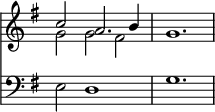
This feature has a singular counterpart in the Handelian recitative, e.g.—

The following examples are more characteristic of the 17th century.

is quoted by Burney (iv. 34) from Peri. In Carissimi and Cesti are found characteristic closes of recitative in this manner—

but in this case the actual rendering is particularly doubtful, and the passage was probably modified after the manner in which recitatives are always rendered. A less doubtful instance, in which there is a string of anticipations, is from a fragment quoted also by Burney (iv. 147) from a Cantata by Carissimi as follows:—

etc.
The use of combinations which result from the simultaneous occurrence of passing notes, a practice so characteristic of Bach, cannot definitely be traced at this early period. Indeed, it is not certain that the musicians had discovered the principle which is most prolific in these effects—namely, the use of preliminary notes a semitone above or below any note of an essential chord, irrespective of what precedes, and at any position relative to the rhythmic divisions of the music, as—

in which B♮, G♯, and D♭, which seem to constitute an actual chord, are merely the result of the simultaneous occurrence of chromatic preliminary passing notes before the essential notes C, A, and C of the common chord of F major. But there is a combination which is very common in the music of the 17th century, which has all the appearance of being derived from some such principle, and demands notice. It appears in Cesti's 'Orontes' (Burney, iv. 68) as follows:—

and, however preceded, it always amounts to the same idea—namely, that of using an unprepared seventh on the subdominant of the key (major or minor) preceding the Dominant chord of the Cadence. This may be explained as a passing note downwards towards the uppermost note of the succeeding concord on the Dominant, which happens to coincide with the passing note upwards between the third of the tonic chord and the root of the Dominant chord,—as C between B♭ and D in the example; in which case it would be derived from the principle above explained; or on the other hand the passage may be explained on the basis of the old theory of passing notes in a way which is highly illustrative of the methods by which novelty is arrived at in music. Composers were accustomed to the progression in which a chord of 6–4 preceded the Dominant chord, as—

and having the particular melodic progression which results from this well fixed in their minds, they inserted a passing note on the strong beat of the bar in the bass without altering the treble, as in the example quoted above from Cesti, and thereby added considerably to the vigour of the passage. This particular feature seems to have been accepted as a musical fact by composers, and appears constantly, from Monteverde till the end of the century, among French and Italians alike; and it is invested with the more interest because it is found in Lully in an improved form, which again renewed its vitality. It stands as follows in a Sarabande by him—

and this form was adopted by Handel, and will be easily recognised as familiar by those acquainted with his works. Corelli indicates the firm hold which this particular seventh had obtained
